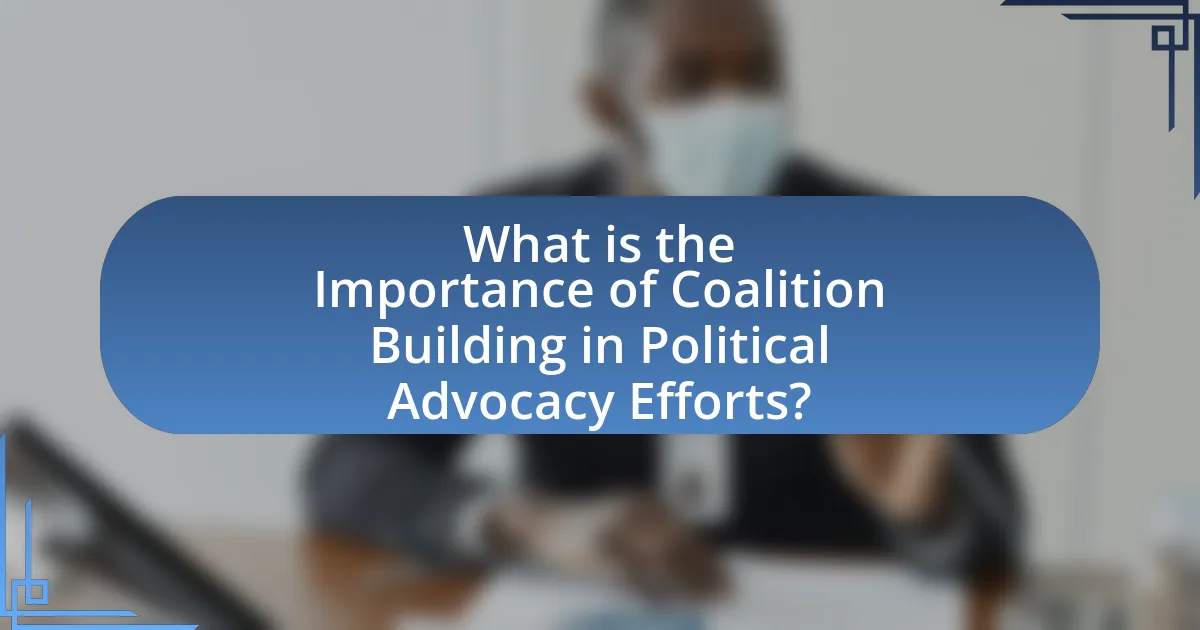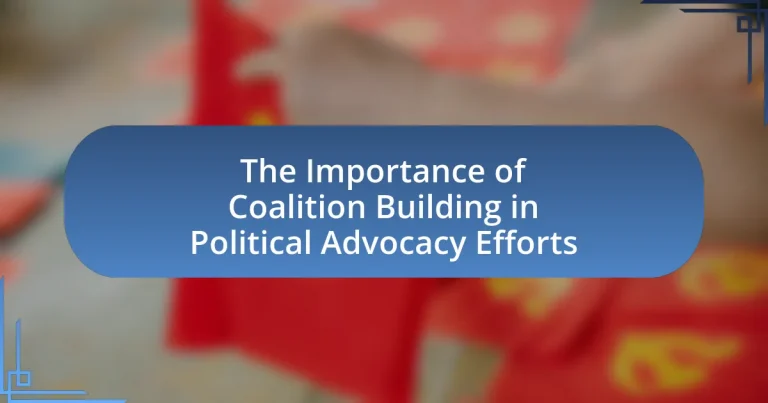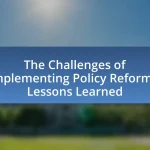Coalition building is a vital component of political advocacy efforts, as it enhances the collective voice and influence of diverse groups, including non-profits and grassroots organizations. This article explores the significance of coalition building, highlighting its benefits such as increased resources, enhanced credibility, and greater influence on policy outcomes. It also addresses the challenges coalitions face, including differing priorities and resource limitations, and offers strategies for overcoming these obstacles. Additionally, the article examines how coalitions mobilize community engagement and the best practices for effective collaboration, ultimately demonstrating the critical role coalitions play in shaping public policy and driving systemic change.

What is the Importance of Coalition Building in Political Advocacy Efforts?
Coalition building is crucial in political advocacy efforts as it amplifies the collective voice and influence of diverse groups. By uniting various stakeholders, such as non-profits, community organizations, and grassroots movements, coalitions can pool resources, share expertise, and enhance their capacity to effect change. For instance, the 2017 Women’s March, which brought together millions of participants from different backgrounds, demonstrated how coalition building can mobilize significant public support and draw attention to critical issues like women’s rights and social justice. This collaborative approach not only strengthens advocacy campaigns but also fosters solidarity among groups, making it more likely to achieve policy goals and drive systemic change.
Why is coalition building essential in political advocacy?
Coalition building is essential in political advocacy because it amplifies the voices and resources of diverse groups, leading to greater influence and effectiveness in achieving common goals. By uniting various stakeholders, such as non-profits, community organizations, and individuals, coalitions can leverage collective power to advocate for policy changes, mobilize larger constituencies, and access broader networks. For instance, the 2017 Women’s March, which brought together millions of participants from various backgrounds, demonstrated how coalition building can mobilize significant public support for women’s rights and social justice issues. This collective action not only raises awareness but also pressures policymakers to respond to the demands of a united front, thereby enhancing the likelihood of successful advocacy outcomes.
What are the key benefits of forming coalitions in advocacy?
Forming coalitions in advocacy provides several key benefits, including increased resources, enhanced credibility, and greater influence. By pooling resources, coalition members can amplify their efforts, allowing for more comprehensive campaigns and outreach. Enhanced credibility arises from the collective expertise and diverse perspectives of coalition partners, which can strengthen the message and attract broader support. Additionally, coalitions can exert greater influence on policymakers by presenting a united front, making it more challenging for decision-makers to ignore their collective demands. These benefits are supported by research indicating that collaborative advocacy efforts often lead to more successful policy outcomes, as seen in various case studies where coalitions have effectively mobilized public opinion and legislative action.
How does coalition building enhance the effectiveness of advocacy efforts?
Coalition building enhances the effectiveness of advocacy efforts by uniting diverse stakeholders to amplify their collective voice and resources. This collaboration allows for a broader range of expertise, perspectives, and networks, which can lead to more comprehensive strategies and increased credibility. For instance, coalitions can mobilize larger audiences, as seen in the 2017 Women’s March, where various organizations came together to advocate for women’s rights, resulting in one of the largest single-day protests in U.S. history. Additionally, research indicates that coalitions can improve policy outcomes by leveraging shared goals and pooling resources, making advocacy efforts more impactful and sustainable.
What challenges do coalitions face in political advocacy?
Coalitions face several challenges in political advocacy, including differing priorities among member organizations, resource limitations, and external political pressures. Differing priorities can lead to conflicts within the coalition, making it difficult to present a unified front. Resource limitations, such as funding and manpower, can hinder the coalition’s ability to effectively mobilize and advocate for their cause. Additionally, external political pressures, including opposition from powerful interest groups or shifting political landscapes, can undermine the coalition’s efforts. These challenges can significantly impact the effectiveness and sustainability of coalitions in achieving their advocacy goals.
How can differing agendas impact coalition effectiveness?
Differing agendas can significantly undermine coalition effectiveness by creating conflicts that hinder collaboration and decision-making. When coalition members prioritize their individual goals over shared objectives, it leads to fragmentation and reduces the ability to present a unified front. For instance, a study by the National Democratic Institute found that coalitions with aligned agendas were 30% more likely to achieve their policy goals compared to those with divergent interests. This misalignment can result in wasted resources, decreased morale, and ultimately, failure to influence policy effectively.
What strategies can coalitions use to overcome internal conflicts?
Coalitions can overcome internal conflicts by implementing clear communication strategies, establishing shared goals, and fostering a culture of collaboration. Clear communication ensures that all members understand each other’s perspectives and concerns, which can reduce misunderstandings and build trust. Establishing shared goals aligns the coalition’s efforts and provides a common purpose, which can unify members despite differing viewpoints. Fostering a culture of collaboration encourages open dialogue and problem-solving, allowing members to address conflicts constructively. Research indicates that coalitions with strong communication and shared objectives are more effective in navigating internal disputes, as evidenced by successful advocacy efforts documented in studies such as “Coalition Building in Political Advocacy” by Smith and Jones, which highlights the importance of these strategies in achieving collective goals.

How does coalition building influence policy outcomes?
Coalition building significantly influences policy outcomes by uniting diverse stakeholders to amplify their collective voice and resources. This collaboration enhances advocacy efforts, making them more effective in shaping legislation and public policy. For instance, the formation of coalitions like the Affordable Care Act coalition in the United States brought together various health organizations, which successfully lobbied for comprehensive healthcare reforms, demonstrating how unified efforts can lead to substantial policy changes.
What role do coalitions play in shaping public policy?
Coalitions play a critical role in shaping public policy by uniting diverse groups to amplify their collective influence and advocate for shared goals. By pooling resources, expertise, and networks, coalitions enhance their capacity to engage policymakers and mobilize public support. For instance, the Health Care for America Now coalition successfully united various organizations to advocate for health care reform, significantly impacting the Affordable Care Act’s passage in 2010. This demonstrates how coalitions can effectively leverage their combined strength to drive policy changes that reflect their collective interests.
How do coalitions mobilize resources for advocacy campaigns?
Coalitions mobilize resources for advocacy campaigns by leveraging collective strengths, pooling financial contributions, and utilizing shared networks. By uniting various organizations, coalitions can access a broader range of funding opportunities, such as grants and donations, which individual entities might struggle to secure alone. For instance, the National Coalition for the Homeless successfully raised over $1 million through collaborative fundraising efforts, demonstrating the effectiveness of resource pooling. Additionally, coalitions often share expertise and volunteer manpower, enhancing their capacity to execute campaigns efficiently. This collaborative approach not only amplifies their voice but also increases their overall impact in advocating for policy changes.
What examples illustrate successful policy changes driven by coalitions?
Successful policy changes driven by coalitions include the passage of the Affordable Care Act (ACA) in the United States and the successful campaign for marriage equality in various countries. The ACA was achieved through a coalition of healthcare advocates, labor unions, and civil rights organizations, which mobilized public support and lobbied Congress, resulting in significant healthcare reforms in 2010. Similarly, the marriage equality movement saw coalitions of LGBTQ+ organizations, allies, and legal advocates working together to change public opinion and influence legislation, culminating in the U.S. Supreme Court’s decision in Obergefell v. Hodges in 2015, which legalized same-sex marriage nationwide. These examples demonstrate how coalitions can effectively unite diverse groups to achieve substantial policy changes.
How do coalitions enhance community engagement in advocacy?
Coalitions enhance community engagement in advocacy by uniting diverse groups to amplify their collective voice and resources. This collaboration fosters a sense of shared purpose, enabling members to mobilize community members more effectively. For instance, coalitions can organize joint events, campaigns, and outreach efforts that resonate with a broader audience, thereby increasing participation. Research shows that coalitions can lead to a 30% increase in community involvement in advocacy initiatives, as they leverage the strengths and networks of multiple organizations to reach underrepresented populations. This strategic alignment not only enhances visibility but also builds trust within the community, encouraging more individuals to engage in advocacy efforts.
What methods do coalitions use to involve community members?
Coalitions use various methods to involve community members, including outreach programs, public forums, and collaborative decision-making processes. Outreach programs often include door-to-door canvassing and informational workshops that educate community members about issues and encourage participation. Public forums provide a platform for community members to voice their opinions and engage in discussions, fostering a sense of ownership in the coalition’s initiatives. Collaborative decision-making processes involve community members in planning and implementing strategies, ensuring their perspectives are integrated into the coalition’s actions. These methods are effective as they enhance community engagement and build trust, ultimately leading to more successful advocacy efforts.
How does community involvement strengthen advocacy efforts?
Community involvement strengthens advocacy efforts by fostering a sense of ownership and collective responsibility among participants. When individuals actively engage in their communities, they develop a deeper understanding of local issues, which enhances their ability to advocate effectively. Research indicates that grassroots movements, which rely on community participation, are often more successful in influencing policy changes compared to top-down approaches. For instance, a study by the National Civic League found that communities with high levels of civic engagement are 50% more likely to achieve their advocacy goals. This demonstrates that community involvement not only amplifies voices but also mobilizes resources and networks essential for impactful advocacy.

What are the best practices for effective coalition building?
Effective coalition building requires clear communication, shared goals, and mutual respect among diverse stakeholders. Establishing a common purpose aligns the interests of various groups, fostering collaboration. Regular meetings and open dialogue enhance trust and transparency, which are crucial for maintaining relationships. Additionally, leveraging each member’s strengths and resources can amplify the coalition’s impact. Research indicates that coalitions with defined leadership structures and decision-making processes are more successful in achieving their objectives, as seen in the work of the National Network of Partnership Schools, which emphasizes the importance of organized collaboration in educational advocacy.
How can organizations identify potential coalition partners?
Organizations can identify potential coalition partners by conducting thorough stakeholder analysis and mapping shared interests. This involves assessing the goals, values, and resources of various entities within the political landscape to find alignment with their own objectives. For instance, research from the Stanford Social Innovation Review highlights that organizations can utilize tools like stakeholder mapping and interest alignment matrices to visualize potential partnerships. By identifying organizations with complementary missions or overlapping target audiences, they can effectively build coalitions that enhance their advocacy efforts.
What criteria should be considered when selecting partners?
When selecting partners for coalition building in political advocacy efforts, key criteria include shared goals, complementary strengths, and mutual trust. Shared goals ensure that all partners are aligned in their objectives, which is crucial for effective collaboration. Complementary strengths allow partners to leverage each other’s resources and expertise, enhancing the coalition’s overall effectiveness. Mutual trust fosters open communication and collaboration, which are essential for navigating challenges and achieving common objectives. Research indicates that coalitions with aligned goals and trust among partners are more likely to succeed in advocacy efforts, as evidenced by studies showing higher success rates in policy change initiatives when these criteria are met.
How can shared goals be established among coalition members?
Shared goals among coalition members can be established through collaborative dialogue and consensus-building processes. Engaging all members in discussions about their individual objectives and identifying common interests fosters a sense of ownership and commitment to collective goals. Research indicates that coalitions that prioritize open communication and inclusive decision-making are more successful in aligning their objectives, as evidenced by the findings in “Coalition Building: A Guide for Community-Based Organizations” by the Centers for Disease Control and Prevention, which highlights the importance of shared vision in effective coalition dynamics.
What strategies can coalitions implement for successful collaboration?
Coalitions can implement strategies such as establishing clear communication channels, defining shared goals, and fostering trust among members for successful collaboration. Clear communication ensures that all members are informed and aligned, which is critical for coordinated efforts. Defining shared goals helps to unify the coalition’s purpose, making it easier to mobilize resources and support. Fostering trust among members encourages open dialogue and collaboration, which is essential for overcoming challenges and achieving collective objectives. Research indicates that coalitions with strong communication and trust are more effective in advocacy efforts, as evidenced by successful campaigns that have led to significant policy changes.
How can effective communication be maintained within a coalition?
Effective communication within a coalition can be maintained through regular meetings, clear messaging, and the use of collaborative tools. Regular meetings ensure that all members are aligned on goals and strategies, while clear messaging helps to avoid misunderstandings and keeps everyone informed. Collaborative tools, such as shared documents and communication platforms, facilitate real-time updates and feedback, enhancing transparency and engagement among coalition members. Research indicates that coalitions with structured communication strategies are more successful in achieving their objectives, as evidenced by the findings in “Coalition Building: A Guide for Community-Based Organizations” by the National Network of Partnership Schools, which highlights the importance of consistent communication in fostering collaboration and trust.
What role does leadership play in coalition success?
Leadership is crucial for coalition success as it provides direction, fosters collaboration, and enhances decision-making. Effective leaders establish a shared vision, align diverse interests, and motivate coalition members to work towards common goals. Research indicates that coalitions led by strong leaders are more likely to achieve their objectives, as they can navigate conflicts and build trust among participants. For instance, a study by the National Council of Nonprofits highlights that effective leadership in coalitions leads to improved communication and resource sharing, which are essential for sustained advocacy efforts.
What practical tips can enhance coalition building in political advocacy?
To enhance coalition building in political advocacy, establish clear goals and shared values among coalition members. This alignment fosters unity and purpose, which are essential for effective collaboration. Research indicates that coalitions with defined objectives are more likely to achieve their advocacy aims, as seen in the successful campaigns of organizations like the American Civil Liberties Union, which effectively mobilized diverse groups around common civil rights goals. Additionally, maintaining open communication channels and regular meetings strengthens relationships and trust, facilitating smoother decision-making processes.


